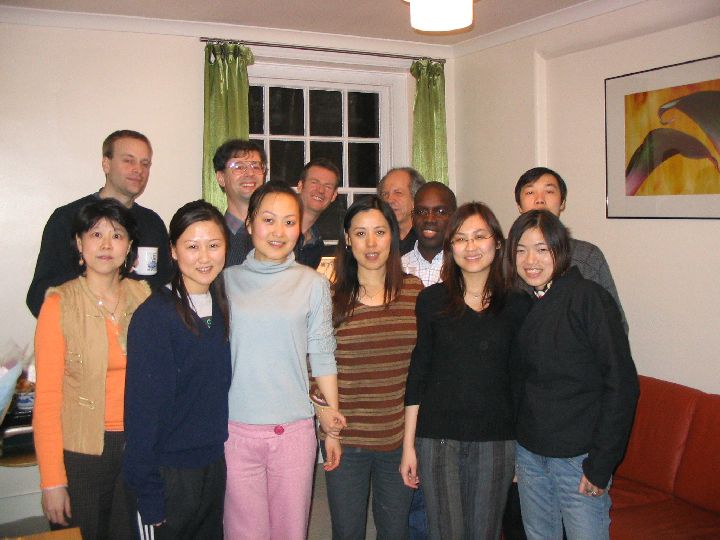25th February 2005

This, the 12th meeting of the London
Youlan Qin Society, was held at the home Cheng Yu in central
London.
Programme
Stephen Dydo: talk on contemporary composition
and ancient Chinese music; Xiao Xiang Shui Yun.
Introduction
Cheng Yu began the proceedings. This was a special event,
not an ordinary yaji, to celebrate the sucessful launch of her
5-string pipa project, and to thank everyone who had worked so
hard and given their support to make it a success.
Just before the yaji began, Oscar Wong of the BBC World Service's
Chinese service interviewed Cheng Yu about her 5-string pipa premiere
concerts (held on Wednesday of the previous week and on the same day as
the yaji). He also interviewed several members of the London Youlan
Qin Sciety.
Contemporary Composition and Ancient Chinese Music
A talk by Stephen Dydo
"I am often asked why, as a Western composer creating contemporary music,
I am interested ancient Chinese music such as the qin. Some Chinese
musicians have asked me why I write music the way I do: it is not modal,
not tonal but chromatic, so it is very different from any Chinese music of
the last 1500-2000 years. However I see no dichotomy, and there is a clear
connection. I shall explain why anybody creating new Western music should
pay close attention to Chinese music.
I shall be talking primarily about Western classical music. "Classical
music" is a loaded term which I define as being a part of a tradition, complex,
generally regarded as a "high art", perhaps even elitist (another loaded
term!) and with a written record. This definition has been true of qin
music even longer than it has for Western classical music. The notion of
classical, or non-folk, music has existed in the West as long as there has
been church music.
There are a number of aspects of contemporary Western music that have
parallels in qin music. One of these is the use of timbre as a low
level motivic device. In Western music we use different orchestration to
stratify different layers of musical development. The notion of using colours
within the melody itself, instead of trills and mordents, has been prevalent
since the 1920s. Schoenberg's Five Orchestral Pieces, op. 16 is a
good example, in which the melody shapes itself by using different tone
colours as the work progresses. This is exemplified in the qin piece
Pu'an Zhou, in which colour changes and moves above and below the
melody. In many qin pieces, the same pitch is produced by playing
harmonics on different strings, giving a different timbral quality to the
same note.
The large-scale form of a qin piece tends to be far less direct
than in traditional Western music. In much contemporary Western music, a
theme appears early in a piece, disappears and reappears later. Brahms did
this in some of his symphonies, but it is much more common in music composed
during the last 50 years. There are more complex structural changes in
large-scale pieces because other things occur over the course of the whole
piece. This is also seen in the qin piece Xiao Xiang Shui Yun:
motifs appear at the beginning of the piece, disappear, and resurface five
minutes or so later. This is very different from, for example, dance suites,
which consist of a sequence of loosely (or more tightly) connnected pieces
of music that don't build on each other. It also differs from Baroque and
classical music, in which complex structural relations occur primarily within
smaller sections, and not across all the movements of a work, so that the
components of a composition are related, but lack thematic development and
the work consists of a set of loose threads woven together. This was common
practice until the mid-19th century.
One of the strands in Xiao Xiang Shui Yun is the idea of
an echo. Melodies fingered on a bass string are echoed on an open string.
Another, that occurs from the very beginning of the piece, is brushing
across the strings that recurs throughout. All these strands occur and are
transformed at various times. Some occur close together, others are
dropped and picked up again later."
Stephen then played Xiao Xiang Shui Yun, after which the
party began. There was an abundance of fine food, drink, and interesting
conversation. Special thanks are due to all those who worked so hard to
provide such a magnificent feast, especially Cheng Yu who was also our host.
Copyright the London Youlan Qin Society, 2005. All
rights reserved.

